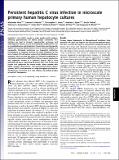Persistent hepatitis C virus infection in microscale primary human hepatocyte cultures
Author(s)
Khetani, Salman R.; Trehan, Kartik; Ploss, Alexander; Jones, Christopher T.; Syder, Andrew J.; Gaysinskaya, Valeriya A.; Mu, Kathy; Ritola, Kimberly; Rice, Charles M.; Bhatia, Sangeeta N; ... Show more Show less
DownloadBhatia_Persistent hepatitis.pdf (939.8Kb)
PUBLISHER_POLICY
Publisher Policy
Article is made available in accordance with the publisher's policy and may be subject to US copyright law. Please refer to the publisher's site for terms of use.
Terms of use
Metadata
Show full item recordAbstract
Hepatitis C virus (HCV) remains a major public health problem, affecting approximately 130 million people worldwide. HCV infection can lead to cirrhosis, hepatocellular carcinoma, and end-stage liver disease, as well as extrahepatic complications such as cryoglobulinemia and lymphoma. Preventative and therapeutic options are severely limited; there is no HCV vaccine available, and nonspecific, IFN-based treatments are frequently ineffective. Development of targeted antivirals has been hampered by the lack of robust HCV cell culture systems that reliably predict human responses. Here, we show the entire HCV life cycle recapitulated in micropatterned cocultures (MPCCs) of primary human hepatocytes and supportive stroma in a multiwell format. MPCCs form polarized cell layers expressing all known HCV entry factors and sustain viral replication for several weeks. When coupled with highly sensitive fluorescence- and luminescence-based reporter systems, MPCCs have potential as a high-throughput platform for simultaneous assessment of in vitro efficacy and toxicity profiles of anti-HCV therapeutics.
Date issued
2010-02Department
Massachusetts Institute of Technology. Institute for Medical Engineering & Science; Harvard University--MIT Division of Health Sciences and Technology; Massachusetts Institute of Technology. Department of Electrical Engineering and Computer ScienceJournal
Proceedings of the National Academy of Sciences
Publisher
National Academy of Sciences (U.S.)
Citation
Ploss, A., S. R. Khetani, C. T. Jones, A. J. Syder, K. Trehan, V. A. Gaysinskaya, K. Mu, K. Ritola, C. M. Rice, and S. N. Bhatia. “Persistent Hepatitis C Virus Infection in Microscale Primary Human Hepatocyte Cultures.” Proceedings of the National Academy of Sciences 107, no. 7 (February 16, 2010): 3141–3145.
Version: Final published version
ISSN
0027-8424
1091-6490